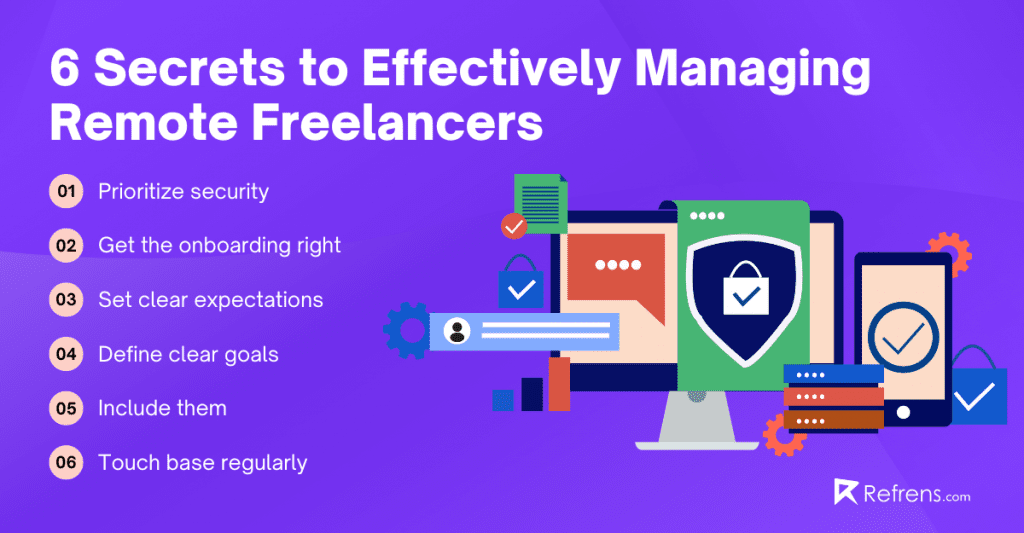There’s a clear difference between in-person employees and remote freelancers – not only are freelancers working independently, but in many cases, management never meets them in person. Feeling disconnected as a result of this remote arrangement can make it harder for businesses to effectively manage, support, encourage, and otherwise engage with freelancers, which in turn, can lead to reduced productivity.
The best way to effectively manage remote freelancers is to take the time to understand what steps can be taken to bridge the gap and engage meaningfully with them.
Here are 8 secrets to efficiently managing remote freelancers, and creating an optimal working relationship that produces great results for all.

1. Prioritize security
With the FBI reporting a staggering 300% increase in cybercrime attacks since the pandemic’s onset, let’s start with the importance of prioritizing security. A business may have a cutting-edge door access system installed on their physical premises, and ideally a robust cybersecurity strategy in place as well – but bringing remote freelancers into the mix can create new challenges.
Remote freelancers invite increased risk, as you can’t always control the devices or networks on which they work; if you need to issue them with access permissions, this can create a security risk.
Check out how to manage the post-pandemic workforce.
Steps to minimizing security risks when managing remote freelancers include:
- If you need to issue remote freelancers with access permissions to apps or other shared tools, always use a password manager. Password managers are an effective security measure to take whenever sharing login credentials with staff members, but particularly important for remote freelance workers.
- Limit the access you provide – evaluate your data security risks and only give access to platforms, social media accounts, and other online tools where it is absolutely necessary. Check out the 6 smart ways to boost your freelance productivity.
- You can also create access levels depending upon need and relevance – keep all data on a need-to-know basis to reduce the risk of security data breaches.
- Set up remote management to view and manage security dashboards and control centers from a mobile phone, tablet, or laptop at any time. Check out the freelance management tools to supercharge your business.
- Converge your security systems to connect and share data to strengthen the comprehensive security strategy (not specific to freelancers, but overall system efficiency will strengthen every aspect of security monitoring and response
- Carry out software updates and patches via the cloud, eliminating the need for in-person maintenance and updates of a server – keeping everything running optimally to assist remote freelancers in accessing what they need to with no interruptions
- Leverage machine learning to detect threats and anomalies across systems
- Depending on the extent of risk that working with a freelancer may imply, it might be necessary to extend your cybersecurity training to your freelance workers. At a minimum, include freelancers in regular updates regarding the latest scams to watch out for
2. Get the onboarding right
Unless it’s a particularly short-term arrangement, make sure to take the time to properly introduce them to the business. Invest some time in getting to know each other a little more personally to build rapport, give them some insight into the business, and set up a meet-and-greet video conference with anyone they may be working with regularly.
The first step is to make sure you hold an official employee onboarding on their first day. Don’t dive straight into tasks. Make sure to take the time to get them set up fully:
This needn’t be a lavish or lengthy process, just some well-spent time gaining a deeper understanding of each other and making them feel valued and well-integrated into the team.
Of course, if you’re expanding globally and taking on a remote hire from overseas, the onboarding process will need to consider local employment laws and regulations (tax, benefits, etc.). This can be made easier using a global hiring partner such as Remote.
Read more about how to minimize risk with new clients.
3. Set Clear Expectations
One of the key aspects of managing any staff member is to set clear expectations, but this is particularly important when managing a freelancer – don’t expect anything to ‘go without saying.’
In addition to not being physically present to read any cues or follow anyone else’s lead, remote freelancers usually work with a variety of clients, all with different expectations of them.
Check out how to avoid over-committing to your clients.
Set your expectations straight out of the gate to avoid unnecessary misunderstandings and inefficiencies. Such expectations could include:
- How best to communicate – when and how best to reach you (taking into account time zone differences, etc.)
Check out how to communicate effectively with your client.
- Work schedule requirements – in line with their availability, outline your requirements regarding the days/hours they will need to work to achieve the desired outcomes (additionally, establish agreed hours per task as necessary to avoid blowing budgets)
- Work disruptions – discuss how you wish for work disruptions to be handled, i.e., in the event that they cannot work due to system upgrades, illness, or other personal circumstances, outline communication and catch-up expectations as applicable
4. Define clear goals and agreed milestones
Again, this is the optimal way to manage any employee, but without any in-person contact, it becomes all the more important to clearly define the goals they are required to work towards, and what milestones must be reached along the way.
Check out 27 ways to align freelancers with your agency’s goals.
Depending on your management style, these may be clearly defined by you or suggested and negotiated between you both; either way, make them crystal clear, and regularly check in for progress updates, and to ensure that there isn’t anything they are struggling with.
5. Include them
Remote workers can feel isolated, and freelancers often even more so – in many cases, freelancers never meet the people they work with in person, so it can be harder to establish a sense of belonging. Finding the best places to work remotely can help bridge that gap by offering environments where freelancers feel connected and motivated, even while working away from a traditional office setting.
The more you can include your remote freelancers in business activities – both professional and social – the better. Wherever relevant, sit them in on meetings, and consider including them in social work events – especially any virtual conference-style catch-ups. The more they connect with other staff members and are kept up-to-date with the business goings-on, the more they will feel motivated to perform and contribute to shared goals.
6. Touch base regularly
Set up a regular schedule for one-on-one check-ins, ideally weekly or even daily depending on how much there is to cover. This helps the freelancer to feel supported and stay on track with their work, and also gives them the opportunity to iron out any concerns without potentially wasting hours or days procrastinating over them.
Recommended Reads: Top 7 Invoice Generator Software
Final thoughts
The more you can foster clear, comfortable, and effective communication with a remote freelancer, the easier it will be to achieve optimal productivity. They may not be there in person, but they have all the same needs when it comes to being effectively led and considered.
Appoint developers remotely that feel part of a team and valued as such tend to outperform those who feel more isolated and professionally stranded. Invest in them and you’ll likely reap what you sow.
Recommended Reads: E-invoicing In GST: A Complete Guide
Recommended Reads: Top Invoicing Software For Consultants



















